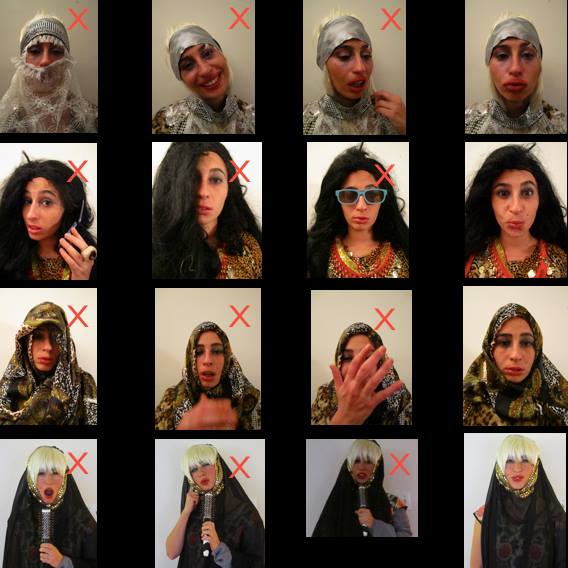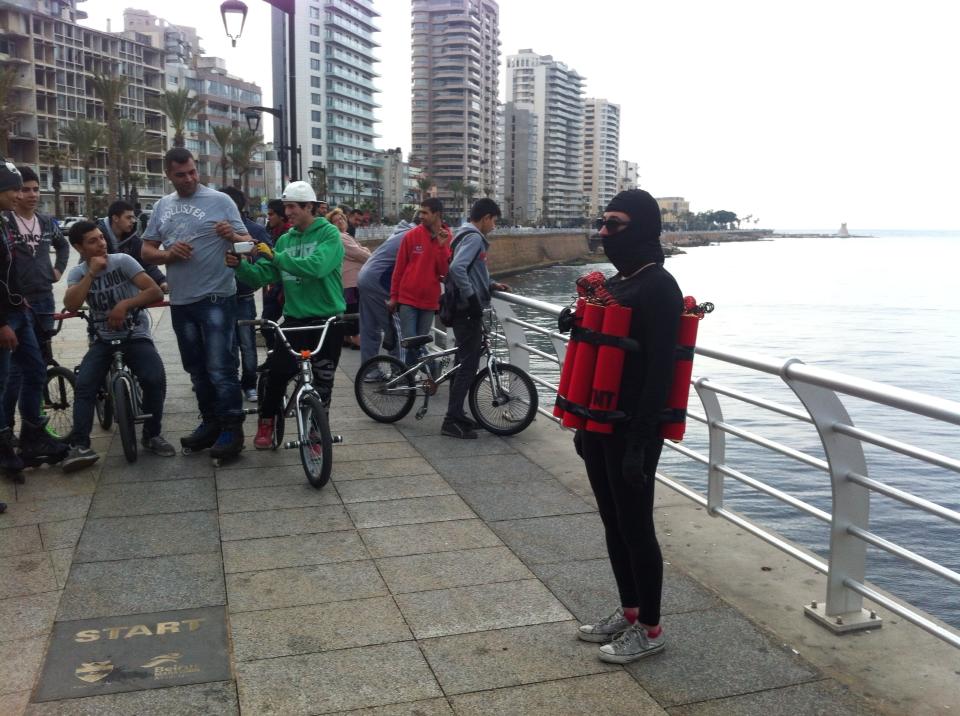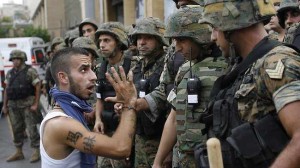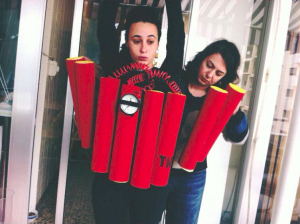
Madame Bomba, known as Rima Najdi in real life, hit the streets of Beirut last Saturday strapped with a cartoon suicide vest worthy of the ACME Corporation.
But Najdi’s “TNT Project” is anything but comical. The Berlin-based Lebanese performance artist dubbed it a “public intervention“, highlighting the climate of fear that smothers Beirut after a year of intensified and devastating bombings.
We caught up with Najdi to get the scoop about her intentions behind The TNT Project, stereotypes about Arab women and her next big project.
Tell us about yourself.
I am a Lebanese artist from southern Lebanon. I grew up in a small town on the coast and studied in Beirut at the Lebanese University. Then in 2010, I moved to New York to pursue my Master’s degree in Performance Studies. I graduated in 2011 and moved to Berlin in 2012, then in 2013 I went back to New York and am now back to Berlin.
I just moved to Berlin, planning to study the German language as I intend to live here with my husband, find a studio space and do my work and maybe find a part time job to pay my bills.
Describe the kind of art that you’ve done and are interested in doing in three words.
Process. Participatory. Researching. And one more: Intriguing.
What’s your favorite project that you’ve done so far?
‘Confession #1’, a lecture performance about ‘Dress ME how YOU like‘.
Why was it special for you?
It evolves all the time. And the fact that I learn creative writing in the process, where I have to stand on a cross road between describing myself as a performer/artist on the one hand and interactions on the other, so in that sense I’m re-learning, discovering my identity, my body, my gender, while Othering it. But the whole project started to question the Other, stereotypes, visual subjects.
What stereotypes were you trying to challenge?
I started with stereotypes of Arab women through Western popular media – for example, early Hollywood production uses the Arab woman as either a princess that belly dances or a ‘jariya‘ oppressed by men and religion, but she does belly dancing as well. Then it moved to only an oppressed woman, but she belly dances anyway. Then a terrorist – as a terrorist, an Arab women won’t belly dance… and also how Arab women are supposedly covered most of the time, even if it’s with very thin clothes… – and how Western women would enact Arab women (Western women = Western actresses, singers etc.).

M.I.A.’s ” Bad Girls” triggered this whole thing… Orientalism and how it works in two directions… I always try to find the space between these two directions, so I use her as a a late reference.
Then the research moved after one year and something to question how in the Arab World, the idea of a “Lebanese woman” could mean anything. In Lebanon, I am Othered and stereotyped according to where I come from. In Egypt, for example, I would as well be stereotyped in a different way as a Lebanese woman. So the research is not about showing these stereotypes but to open a conversation and to try and discuss what they do.
Let’s talk about The TNT Project. How did you come up with the idea and what was your goal?

I was visiting Lebanon recently, as most Lebanese in the diaspora do. I knew that the political situation is not an easy one and that it’s getting worst over time, but as soon as I got there I sensed the amount of depression, agressivity and indifference to a certain extent.
In less then a week from my arrival, a bomb went off in Beirut. I tried to distance myself from this accident, however, I think I was in a state like everyone else in shock, especially that a young kid died in this bomb amongst others… the press wrote about it, however headlines in newspapers and on broadcasted TV was mostly about Shateh. I won’t talk more about how horrible it was and distancing myself made it more horrible.

That was the day after Christmas. In a week, the day after New Year, I was with family and someone says, ‘There is no phone connection. Maybe a bomb exploded.‘ I firstly smiled about signifiers for Lebanese and how horrible it is, then turned on the TV to check the news. I tried to call my mom and dad to tell them that we are okay, but there was no connection.
Then I wanted to go to meet friends in my car. The car wasn’t moving for half an hour from the traffic, still trying my mom, no connection, horns and sirens, a sentiment of panic and fear that I think everyone had to deal with.
The next day in my car to meet some friends, I stopped at a red light. I noticed that I was looking at the cars around me and started thinking about how we are all threatened, no one can be safe. No one knows how, when, where the next bomb could go off, especially after getting messages with car plates numbers that citizens should be aware of. So everyone becomes suspicious and looks at each car with fear.
Looking outside my window, I turned the volume of music up, but it didn’t help at all to distract myself from this feeling of, ‘I might die anytime soon.‘ I looked at the cars next to me and I noticed that they as well were looking for the suspicious car.
When I arrived at the coffee shop where I was meeting my friends, we spoke about this feeling. My friend said that he was walking and he noticed as well that he was observing cars and people and he started wondering why he was thinking that way.

I think the state of violence and intolerance towards each other in Beirut has reached its limits. People are not angry with each other because of difference, but because of fear. Fear makes you do a lot of things and it doesn’t as well. You can cry… but fear of death – to imagine constantly that you could die at any moment – death as the only truth… so I was going crazy a bit with all these feelings and I didn’t want to be indifferent towards fear and death.
I thought it was a valid fear, and it seemed to me to be a collective one, making everyone more aggressive and individualistic to a certain extent.
Given that I like to work with apparel in my art practice – costumes and personas – then it came to me the idea of doing a cartoonish costume of a TNT bomb. I collaborated with Rayya Kazoun, a fashion designer, and Maria Kassab, a visual artist…
Now why a cartoonish costume? Answer: I wasn’t trying to kill myself!

What were their reactions when you told them? What kind of reactions did you expect from the public?
Maria jumped on the idea. Maria is a great friend and a great artist, she inspires me a lot as well and she offered her space to do the meeting. Maria introduced me to Rayya as I was talking about my idea and spelling out for her what I needed. I met with Rayya the second day and Maria.
I was coming while calling the project off in my head for the lack of time, but Rayya was prepared, show me costumes and they both said that they will help Saturday. Rayya and I went shopping, my brother helped me a lot as well. We all met at Rayya’s place/studio and worked on the costume. When it was done, I started panicking until the moment of the intervention.
In this kind of work you need not to expect from the public. You need to be very open.
How did you get over your nerves? Did you ever consider canceling the intervention?
Not once we were constructing the costume… When I said, ‘Okay, let’s do it,‘ there was no going back at that moment. Let’s do it. Then it was mostly dealing with fear and illusion. I did not know what to expect from people, which helped to be more afraid.
My husband was in Berlin he thought it was not a good idea and my parents did not like the idea and thought I should tell the police, but they thought that it was another crazy project.

Did you run into any problems with spectators or police or anything?
I made a choice not to argue with people to answer them in questions just so they can react. The police were having more fun then anyone, I think. One police told me, ‘bwali3? boom.‘ Private security, on the other hand, and privatized public spaces did not allow me in. That was problematic, but I didn’t want to argue. I just asked them why and recorded their answers as we weren’t allowed to film or take pics.,,
What did regular people on the street say to you? And what kind of questions would you reply to them?
A few people argued with me about how what I was doing doesn’t mean anything. Some people asked, ‘Is it real? How much does it weigh? Is this is the trend now?‘ I didn’t respond to these questions since they came in the form of commenting during the intervention, but some followed me while walking and started to ask me, ‘Why are you doing this?‘ I would respond, ‘Why do you think?‘
Responses varied. Others is when a guy starting clapping for me, someone shouting ‘Got the message, just leave already‘, a guy with his phone started directing others to move out from the frame so he can film. He spent some time to film me and people would ignore him. A security guard that thought I was sent by a hidden camera program and started looking around, asking, ‘Where is the hidden camera?‘, smiling all the time nervously. An intellectual who thought this was not doing anything and was not intriguing since it’s comical started to argue with me about my aesthetic choices and how I was not portraying reality. People passing by and not really looking, just glancing from far away – I think these moments were very important. And for sure the guard who brought a dog to sniff me… The dog was adorable!
What do you think of the #notamartyr selfie protest campaign?
Hm, I was asked this question many times and I am still not familiar with this campaign. Someone sent me videos about it, but honestly I didn’t have the time to really look at it, but as I understood it’s a virtual campaign… Well, I think these type of campaigns are very useful in terms of expressing oneself in speech acts, but still it doesn’t challenge anyone to go out from their comfort zones…
Give us the scoop on your next big project.
I would love to be able to write a lecture performance with the material that I have from this project and/or to do what I intended to do when I started the intervention, which is a short documentary. I don’t know yet. According to the material that I have, I’ll sense what is better to do… I’m afraid that I just raised the challenge for myself drastically.
WE SAID THIS: For more about Rima’s work, check out her website.



